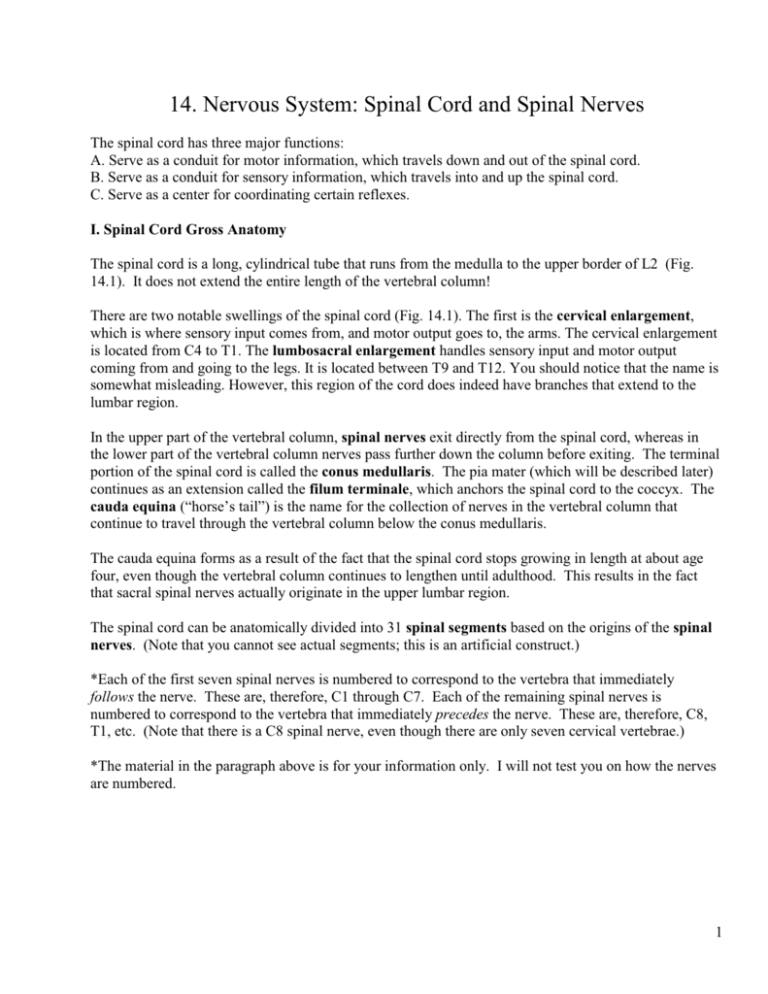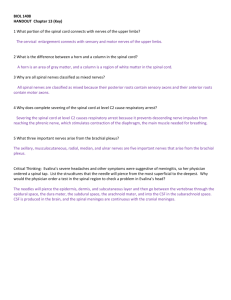14. Nervous System: Spinal Cord and Spinal Nerves
advertisement

14. Nervous System: Spinal Cord and Spinal Nerves The spinal cord has three major functions: A. Serve as a conduit for motor information, which travels down and out of the spinal cord. B. Serve as a conduit for sensory information, which travels into and up the spinal cord. C. Serve as a center for coordinating certain reflexes. I. Spinal Cord Gross Anatomy The spinal cord is a long, cylindrical tube that runs from the medulla to the upper border of L2 (Fig. 14.1). It does not extend the entire length of the vertebral column! There are two notable swellings of the spinal cord (Fig. 14.1). The first is the cervical enlargement, which is where sensory input comes from, and motor output goes to, the arms. The cervical enlargement is located from C4 to T1. The lumbosacral enlargement handles sensory input and motor output coming from and going to the legs. It is located between T9 and T12. You should notice that the name is somewhat misleading. However, this region of the cord does indeed have branches that extend to the lumbar region. In the upper part of the vertebral column, spinal nerves exit directly from the spinal cord, whereas in the lower part of the vertebral column nerves pass further down the column before exiting. The terminal portion of the spinal cord is called the conus medullaris. The pia mater (which will be described later) continues as an extension called the filum terminale, which anchors the spinal cord to the coccyx. The cauda equina (“horse’s tail”) is the name for the collection of nerves in the vertebral column that continue to travel through the vertebral column below the conus medullaris. The cauda equina forms as a result of the fact that the spinal cord stops growing in length at about age four, even though the vertebral column continues to lengthen until adulthood. This results in the fact that sacral spinal nerves actually originate in the upper lumbar region. The spinal cord can be anatomically divided into 31 spinal segments based on the origins of the spinal nerves. (Note that you cannot see actual segments; this is an artificial construct.) *Each of the first seven spinal nerves is numbered to correspond to the vertebra that immediately follows the nerve. These are, therefore, C1 through C7. Each of the remaining spinal nerves is numbered to correspond to the vertebra that immediately precedes the nerve. These are, therefore, C8, T1, etc. (Note that there is a C8 spinal nerve, even though there are only seven cervical vertebrae.) *The material in the paragraph above is for your information only. I will not test you on how the nerves are numbered. 1 II. Protection and Support of the Spinal Cord The spinal cord is protected by three layers of tissue, called spinal meninges, that surround the cord (Fig. 14.3): A. The dura mater is the outermost layer, and it forms a tough protective coating. Between the dura mater and the surrounding bone of the vertebrae is a space, called the epidural space. The epidural space is filled with adipose tissue (why is this relevant to protection of the spinal cord?), and it contains a network of blood vessels. B. The arachnoid mater is the middle protective layer. Its name comes from the fact that the tissue has a spiderweb-like appearance. The space between the arachnoid and the underlyng pia mater is called the subarachnoid space. The subarachnoid space contains cerebrospinal fluid (CSF). The medical procedure known as a “spinal tap” involves use of a needle to withdraw CSF from the subarachnoid space, usually from the lumbar region of the spine. C. The pia mater is the innermost protective layer. It is very delicate and it is tightly associated with the surface of the spinal cord. III. Sectional Anatomy of the Spinal Cord The spinal cord is somewhat compressed dorso-ventrally, giving it roughly an oval shape in crosssection (Fig. 14.4). The cord has grooves in the dorsal and ventral sides; these are named the posterior median sulcus and the anterior median fissure, respectively. Running down the center of the spinal cord is a cavity, called the central canal. Each segment of the spinal cord is associated with a pair of ganglia, called posterior (or dorsal) root ganglia, which are situated just outside of the spinal cord (Fig 14.5). These ganglia contain cell bodies of sensory neurons. Axons of these sensory neurons travel into the spinal cord via the posterior (or dorsal) roots. Anterior (or ventral) roots consist of axons from motor neurons, which bring information to the periphery from cell bodies within the CNS (Fig. 14.5). Posterior roots and anterior roots come together and exit the intervertebral foramina as they become spinal nerves. The gray matter, in the center of the cord, is shaped like a butterfly and consists of cell bodies of interneurons and motor neurons (Figs. 14.4 and 14.5). It also consists of neuroglia cells and unmyelinated axons. Projections of the gray matter (the “wings”) are called horns. Together, the gray horns and the gray commissure form the “gray H.” The white matter is located outside of the gray matter and consists almost totally of myelinated motor and sensory axons (Fig. 14.4). Funiculi (or columns) of white matter carry information either up or down the spinal cord. Within the CNS, nerve cell bodies are generally organized into functional clusters, called nuclei. Axons within the CNS are grouped into tracts. 2 IV. Spinal Nerves Refer to Fig. 14.13 and identify the sympathetic trunk ganglion, the rami communicantes, the posterior ramus of the spinal nerve, and the anterior ramus of the spinal nerve. Shortly after a spinal nerve exits the intervertebral foramen, it branches into the posterior ramus, anterior ramus, and rami communicantes. Each of these latter three structures carries both sensory and motor information. Because each spinal nerve carries both sensory and motor information, spinal nerves are referred to as “mixed nerves.” Posterior rami carry visceral motor, somatic motor, and sensory information to and from the skin and muscles of the back. Anterior rami carry visceral motor, somatic motor, and sensory information to and from the ventrolateral body surface, structures in the body wall, and the limbs. The rami communicantes carry visceral motor and sensory information to and from the visceral organs. Posterior rami remain distinct from each other, and each innervates a narrow strip of skin and muscle along the back, more or less at the level from which the ramus leaves the spinal nerve. Anterior rami of the thoracic region also remain distinct from each other, and each innervates a narrow strip of muscle and skin along the sides, chest, ribs, and abdominal wall. These rami are called the intercostal nerves (Fig. 14.15). In regions other than the thoracic, anterior rami converge with each other to form networks of nerves called nerve plexuses. Within each plexus, fibers from the various anterior rami branch and become redistributed so that each nerve exiting the plexus has fibers from several different spinal nerves. One advantage to having plexuses is that damage to a single spinal nerve will not completely paralyze a limb. There are four main plexuses formed by the anterior rami: The cervical plexus contains anterior rami from spinal nerves C1-C5 (Fig. 14.16). Branches of the cervical plexus, which include the phrenic nerve, innervate muscles of the neck, the diaphragm, and the skin of the neck and upper chest. The brachial plexus contains anterior rami from spinal nerves C5-T1 (Fig. 14.17). This plexus innervates the pectoral girdle and upper limb. The lumbar plexus contains anterior rami from spinal nerves L1-L4 (Fig. 14.18). The sacral plexus contains anterior rami from spinal nerves L4-S4 (Fig. 14.19). The lumbar and sacral plexuses innervate the pelvic girdle and lower limbs. 3









